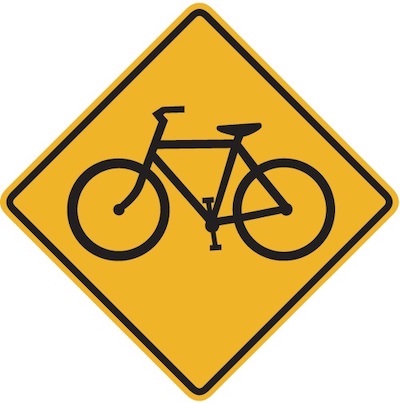A bike road sign meanings a designated path or lane for cyclists. It ensures safety and organization on the road.
Bike road signs play a crucial role in traffic management. They provide clear directions and designated spaces for cyclists. These signs help prevent accidents by separating bike lanes from motor vehicle lanes. Cyclists can navigate more confidently, knowing they have a specific area to ride.
Motorists also benefit, as they are more aware of cyclists’ presence. Proper signage improves overall road safety and encourages more people to use bicycles.
This can lead to reduced traffic congestion and a healthier environment. Understanding and adhering to bike road signs fosters a safer and more efficient transportation system.

Credit: bicycledutch.wordpress.com
Introduction To Bike Road Signs
Bike road signs help cyclists stay safe. They show important information. Knowing these signs helps avoid accidents. Cyclists must follow these signs. This keeps everyone safe on the road.
Cyclists must watch for bike lane signs. These signs show where bikes can ride. Stop signs tell cyclists to stop completely. Yield signs mean to give way to others.
Speed limit signs tell how fast you can go. Always follow the speed limit. Directional signs help you find your way. They show which direction to go.
Common Bike Road Signs Explained
Bike lane markings show where cyclists should ride. Solid white lines mark the edges. Dashed lines show merging points. Symbols like a bike icon guide cyclists. Green paint highlights danger zones.
Sharrows are shared lane markings. They show cyclists can use the full lane. Arrows and bike symbols guide the way. “Bicycles May Use Full Lane” signs remind drivers to share.
Yellow diamond signs warn of upcoming dangers. “Bike Crossing” signs show where paths cross roads. “Yield to Bikes” signs tell drivers to give way. “Watch for Bikes” alerts drivers to look out for cyclists.
Interpreting Traffic Lights And Signals
Cyclists must understand bike road signs to ensure safe rides. Traffic lights and signals guide bikers through intersections and roadways. Recognizing these signs helps prevent accidents and promotes smooth travel.
Traffic Lights Specific To Bikes
Bikes have their own traffic lights. These lights are usually smaller. They may show a bike symbol. Green lights mean it’s safe to go. Red lights mean you must stop.
Yellow lights mean slow down and prepare to stop. Always obey bike traffic lights for safety. They help prevent accidents. They keep everyone safe on the road.
Hand Signals And Their Meaning
Bikers use hand signals to show their actions. Left turn is shown by extending the left arm straight out. Right turn is shown by extending the right arm straight out or by raising the left arm with the elbow bent.
Stopping is shown by extending the left arm down with the palm open. These signals help other road users know your intentions. Using hand signals can prevent accidents. They make biking safer for everyone.

Credit: www.reddit.com
Right Of Way Rules For Bikers
Bike riders must know the rules to stay safe at intersections. Always stop at red lights and stop signs. Look both ways before crossing any street. Yield to pedestrians and other vehicles if needed. Always use hand signals to show your turns. This helps drivers understand your next move.
On shared roads, bikes and cars must share the space. Bikers have the right to use the whole lane. Stay in the bike lane if there is one. Always give way to emergency vehicles. Ride in the same direction as traffic. This helps others see you better.
Directional Signs And Wayfinding
Bike route markers help riders stay on track. These signs often show arrows and numbers. Arrows point the way to go. Numbers might show the route number. Riders can find these signs on poles and posts.
Staying on the correct path is easy with these signs. They show clear directions. Missing a sign can lead to getting lost.
Distance signs tell how far a place is. These signs can show miles or kilometers. Knowing the distance helps riders plan breaks.
Destination signs point to places like parks and towns. They often have names and arrows. Riders can see what is ahead. These signs are very helpful.
Regulatory Signs: Do’s And Don’ts
Cyclists must follow certain signs for safety. Stop signs mean you must stop and look both ways. Yield signs mean you must give way to others. Bike lanes are for cyclists only. Always use hand signals to show your moves.
Some signs tell cyclists what not to do. No entry signs mean you cannot go through. No turn signs mean you cannot turn in that direction. No parking signs mean you cannot park your bike there. Pay attention to these signs to avoid trouble.
Warning Signs: Hazards And Alerts
Cyclists should always be alert to road conditions. Potholes, gravel, and uneven surfaces can cause accidents. Watch for warning signs indicating these hazards. Wet roads can be slippery, especially after rain. Keep an eye on the weather and dress appropriately. Riding safely depends on understanding the road ahead.
Knowing alert signals can save lives. Red triangles often signal danger. Yellow signs warn of upcoming curves or steep hills. Look for these signs to stay safe.
Follow the road rules and be cautious. Always wear a helmet and use lights at night. Cyclists must be aware of their surroundings at all times.
Special Signs For Bicycle Paths
Exclusive bike path indicators are designed for cyclists only. They ensure safe travel. These signs are usually blue and white. They show a bicycle symbol. They warn cars and pedestrians. They should not enter these paths. Following these signs is important. It keeps everyone safe.
Multi-use trail signs allow different users. Both cyclists and walkers use these paths. These signs often have multiple symbols. They show bikes, walkers, and sometimes horses.
These signs help avoid confusion. Everyone knows where to go. They promote sharing and safety on trails.
Road Sign Placement And Visibility
Bike road signs enhance safety by clearly indicating designated cycling paths. Proper placement ensures maximum visibility for cyclists and motorists, reducing accidents. Effective signage helps everyone share the road responsibly.
Strategic Locations For Maximum Awareness
Bike road signs should be placed where they can be easily seen. They must be at eye level for bike riders. Placing signs near bike lanes is crucial. Busy intersections are also important spots. Signs need to be visible from a distance.
This helps riders prepare in advance. Large fonts and bright colors improve visibility. Reflective materials make signs visible at night. Regular maintenance ensures signs stay clear. Signs should not be blocked by trees or buildings.
Challenges Of Signage Visibility
Weather conditions can affect sign visibility. Fog or heavy rain can obscure signs. Dirt and grime can also cover signs. Snow can block signs completely. Poor lighting makes signs hard to see at night. Vandalism can damage signs.
Signs may fade over time. Regular checks and cleaning are necessary. Replacing damaged signs keeps riders safe. Proper lighting can help improve nighttime visibility.
Advancements In Bike Signage Technology
Electronic signs are changing how cyclists ride. They show real-time updates about traffic. Bike lanes with electronic signs are safer. LED displays are easy to see at night.
Cyclists get alerts about road conditions. Weather updates help cyclists plan their route. These signs are solar-powered to save energy.
Smart signs will soon guide cyclists. These signs will use GPS technology. Cyclists will get personalized messages. Interactive signs will respond to cyclists’ needs. Eco-friendly materials will be used for new signs.
Voice commands may help cyclists stay safe. Augmented reality could be the next big thing. Bike rides will be more enjoyable with these advancements.
Bike Signage Around The World
Bike signs can look different around the world. In some countries, blue signs show bike lanes. Other places use green signs. Some signs have a bike symbol with arrows. These arrows show the direction for bikes.
European countries often use circle signs. These circles are usually blue or red. In Asia, bike signs are sometimes painted on the road. This helps bikers know where to ride.
Learning from other countries can make our roads safer. Clear signs help bikers and drivers. Consistent signs reduce confusion. Bright colors and simple symbols work best.
Countries with good bike signs have fewer accidents. Sharing ideas about signs can help everyone. Good signs mean safe biking for all.
Educational Resources And Learning Tools
Many websites offer online guides about bike road signs. These guides help you understand different signs. They explain what each sign means clearly. Visual aids like images and videos are also provided. This makes learning easier and more fun. You can access these guides anytime and anywhere. Many of these guides are free to use.
Cycling safety courses teach you about bike road signs. These courses are available online and offline. Workshops are also held in many places. In these workshops, you learn by doing practical activities.
Experts explain each sign and its importance. You can ask questions and get instant answers. These courses and workshops make you a better and safer cyclist.
Conclusion: Riding With Confidence
Understanding bike road signs ensures safer and more confident riding. These signs help cyclists navigate roads with ease.
The Role Of Road Signs In Cycling Culture
Road signs guide cyclists on their journey. They help avoid accidents and ensure safety. Knowing these signs is very important. Every sign has a purpose and tells you what to do. Some signs show where to stop or slow down.
Others indicate bike lanes or warn of possible dangers. Understanding these signs makes cycling easier and safer.
Learning road signs boosts a cyclist’s confidence. It helps them ride safely on busy streets. Kids and adults alike should learn these signs. Schools and communities can teach the meanings of these important signs.
This knowledge empowers cyclists. It makes them more aware and vigilant. Everyone benefits from educated riders who know and respect road signs.

Credit: www.bikemn.org
Frequently Asked Questions
What Does The Bike Symbol Mean?
The bike symbol indicates a designated area for cyclists. It promotes safety and proper traffic flow on roads.
What Does Cycle Symbol On Road Mean?
The cycle symbol on the road indicates a designated lane or path for cyclists. It promotes safer, efficient travel for cyclists.
What Is The Meaning Of The Bike Lane Sign?
A bike lane sign indicates a designated lane for bicycles. It ensures cyclist safety and promotes organized traffic flow.
What Does The Bicycle Symbolize?
A bicycle symbolizes freedom, independence, and sustainability. It represents a healthy lifestyle and eco-friendly transportation.
What Does A Bike Road Sign Indicate?
A bike road sign indicates a designated bike path or lane for cyclists.
Conclusion
Understanding bike road signs ensures safer rides for everyone. Always stay alert and follow these crucial signals. Your safety and the safety of others depend on it.
Learn and recognize these signs to enhance your biking experience. Happy and safe riding!

Dr. Michelle Spiel, a distinguished Australian dentist and a devoted cyclist, has seamlessly integrated her passion for healthcare and cycling into a remarkable journey of achievement and dedication.




Leave a Reply